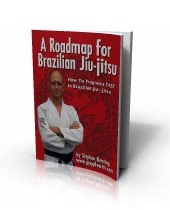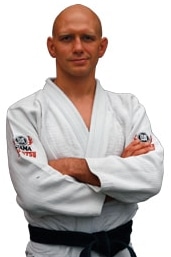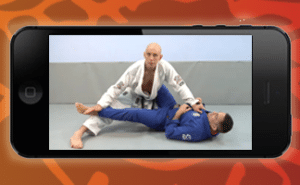
We’ll get to the Mount Everest part later, but first let me tell you a story about the other day when I was sparring with a black belt training partner…
My partner was using the spider guard, a position he’s spent quite a bit of time developing in the last year. I got sloppy for a second and he slammed on a triangle choke from the double biceps spider guard position (using a variation of this triangle choke setup here).
I postured up right away so the triangle wasn’t fully applied: only his ankles were crossed, my head was up and my eyes were staring at the ceiling. I had lots of room, the choke wasn’t on, and I was still (temporarily) safe…
Now as I’ve discussed before, there are 3 stages of escape to every submission: early, middle and late.
Early escapes are preventative and get are used before your opponent has the submission applied. Early escapes are the best option: it’s way better not to get into a bad position than it is to fight your way out of the hole later on.
Middle stage submission escapes are applied as your opponent is snugging up and adjusting the position.
And late escapes are last ditch Hail Mary type moves that sometimes get you out of submission even it’s fully applied. These escapes have the lowest success rate and mostly rely on you being lucky and your opponent screwing up.
So there I was: I’d screwed up and missed my opportunities to block the triangle choke as it was being set up. So no more early escapes for me.
We were now fighting in the middle stage…
The battle in this situation is all about posture and the grips: he was trying to get his hands past my defenses in order to pull my head down. Meanwhile I was trying to get him to keep his hands to myself, preserving my posture, and setting up my middle-stage escape.
Eventually he got a solid grip high on my lapel that turned my entire torso into one big lever. He pulled hard with his arms while at the same time also giving a big knees-to-chest pull with his legs; I began to teeter, then fell forward, my posture now essentially shot to hell.
He began to make all the adjustments that tighten a triangle choke (getting an angle, adjusting his legs, triangling foot behind his knee, etc.). We had emphatically arrived at the late stage of the triangle choke.
This was the end game now.
At this point there were still some perfectly triangle choke defences available to me. For example there’s the ‘Foot in the Armpit’ escape (the third technique in the video on this page here) that I’ve used to weasel out of many almost-fully-applied triangle chokes in the past.
I could still breath. Blood was still flowing to my brain. There was still a chance to escape!!
But instead I tapped out right away.
Why on earth would I give up then? I wasn’t in pain… and I wasn’t about to pass out…
But prior to this sparring session an old work injury had flared up and my neck had been bugging me. It was aching, sure, but hadn’t yet flared up into something unmanageable.
Yes, I could have toughed it out longer. Yes, I could have made my partner work harder for that submission. Yes, with a little luck I might even have escaped the triangle itself.
But no matter what happened at that point, with the triangle fully locked on my neck would have taken a beating. It would have gotten bent, twisted, and squished.
And if that trauma had caused it to flare up then I would have missed days or even weeks of training, waiting for the damn thing to stop aching.
I’ve learned from experience that being a tough guy in situations like this is counterproductive. Training in class isn’t the same as competing in the finals of the Mundials or a title fight in the UFC. Instead of being a tough guy and suffering right through to the bitter end I suggest you tap early and tap often, especially when it’s a problem area that’s under attack.
Better to tap out and continue to train pain free than it is to beat up your body and have to take time off.
Before that training even started I had consciously told myself that if I was caught in any position that compromised the neck I would tap out. It didn’t matter if it was a sloppy guillotine, a triangle choke, or even just some awkward position that wasn’t even a submission: if my head or neck got bent or twisted that day then I was tapping out, even if it didn’t hurt at the time.
This kind of risk-reward calculation can be hard to do in the heat of the moment. You’re rolling, adrenaline is flowing, and the ego gets involved. “Yes it hurts,” you might say, “but damned if I’m gonna tap to this guy because of this technique that I can usually get out of…” And then – twist, turn, BOOM – you get injured.
The trick is to do make these sorts of bailout decisions BEFORE you’re actually training.
Make a commitment in advance about when you’re gonna tap, before the adrenaline and ego kick in.
Here’s where Everest comes in…
I don’t climb much myself, but I love reading mountaineering books and watching climbing films. The idea of pushing yourself to your limits in an outdoor setting is very appealing to me.
Of course the tallest mountain in the world is Everest. Getting to the top is usually a multi-day slog from camp to camp, with a big push to get to the summit on the last day.
By summit day you’re in the so-called “Death Zone.” The oxygen levels above 26,000 feet are so low you’re physically feeble, your brain is working in slow motion, and you’re dying by degrees. Stay up there long enough and you’re gonna die, no doubt about it.
Furthermore most fatalities on Everest occur on the descent. By the time you’re climbing down again you’re exhausted, darkness is coming, and temperatures are dropping quickly.
To avoid dying on the descent many mountaineers set a turn-around time. This is a time of the day – often 2 pm – at which they’re going to turn around regardless of whether they’ve summited Everest or not. So even if they’re only a few hundred feet away from the summit and 2 pm strikes they’re stopping, turning around, and going back down.
The excellent book ‘Into Thin Air’ by Jon Krakauer (and the very good 2015 movie ‘Everest’) depict in detail what happened when mountain guide Rob Hall broke his own rule and tried to get client Doug Hansen to the summit after the turnaround time. Spoiler: both climbers died, as did 6 other people on the same mountain that same day.
The turnaround time on Everest is there to prevent you from making difficult decisions when your brain is addled by lack of oxygen.
And deciding in advance to tap out early for certain submissions is there to help you make the right decision when your brain is addled by adrenaline, testosterone and ego.
I’m a black belt because I’ve tapped out more than white, blue, purple or brown belts.
Tap out early. Tap out often. Don’t get new injuries and don’t make old injuries worse.
Be the tortoise, not the hare. Go slow to go fast. Jiu-jitsu is for life.
P.S. If you found this article useful and would like more tips, techniques and strategies to keep your jiu-jitsu training safe and efficient then check out the free app by Stephan Kesting and Grapplearts.com called ‘A Roadmap for Brazilian Jiu-Jitsu.’
This video-based instructional app will download directly to your Apple or Android device, be it a phone or tablet. Click here for more information about that app and links to download it for free.



